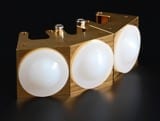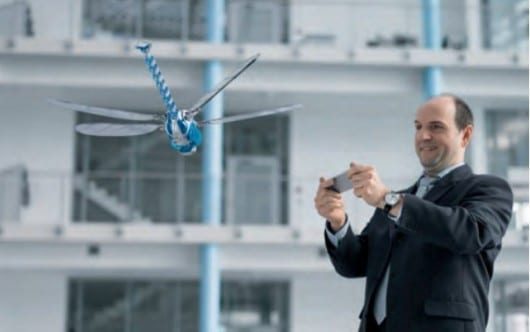
Suitable for a broad range of applications, from traffic controls and medical technology to logistics and industrial sensor technology
The human eye cannot see through wood, paper, or plastic. But a compact radar with a modular design now makes it possible to see the invisible: The millimeter wave sensor penetrates non-transparent material. It transmits signals at frequencies between 75 and 110 GHz and can be applied in a broad range of areas, from flight safety and logistics to industrial sensor technology and medical technology. Fraunhofer researchers are presenting a prototype of the radar at this year‘s Hannover Messe, which is set to take place from April 8 to April 12. They will be located at Stand D18 in Hall 2.
The mountain rescue helicopter is moving very slowly and carefully toward to the scene of an accident. A few minutes ago, two snow-shoers placed an emergency call to the base. One of two men was injured and unable to walk back down the mountain. Very carefully, the pilot begins to land. This is a risky maneuver, as freshly fallen snow makes the approach difficult. The rotor downwash causes the soft, loose snow to swirl upward. Within seconds, a cloud of snow surrounds the helicopter. In whiteouts like these, pilots lose their reference points and cannot tell whether the helicopter is moving upward or downward. Such difficult landing maneuvers will soon be issue of the past: researchers at the Fraunhofer Institute for Applied Solid State Physics IAF, for Manufacturing Engineering and Automation IPA, and for Reliability and Microintegration IZM are working together to develop a radar that can provide landing support in all ambient conditions. Whether in snow clouds, dust, or fog, the radar is capable of measuring exact heights and distances to the ground. This radar works with millimeter waves at frequencies of 75 to 110 GHz, usually known as the W-band. Even in situations of difficult visibility, it can identify small objects at a range of up to 3 kilometers. In contrast to optical sensors, the millimeter wave sensor is capable of penetrating all dielectrical, non-metallic and non-transparent materials, such as clothing, plastic surfaces, paper, wood, or even snow and fog.
This makes the W-band radar suitable for a broad range of applications, from traffic controls and medical technology to logistics and industrial sensor technology. This includes, for instance, the monitoring of container ports or manufacturing processes. “The W-band radar can be used in any situation where other sensor technologies in manufacturing processes have failed because of high temperatures or limited visibility. Just to name one example, it can be used as a filling level sensor in flour silos: a great deal of dust forms when they are being filled,“ says Dr. Axel Hülsmann, an engineer at IAF. And the device has other advantages as well: in contrast to x-ray scanners, it does not pose a health hazard, and it works with short-wave beams in the millimeter range. It has a transmission power of 10 milliwatts, compared with the 1000-milliwatt range of a mobile phone.
About the size of a cigarette box
Existing radar systems, which are based on ceramic substrates, are expensive, large, and weigh four to five kilograms. This limits where they can be deployed, and they are mainly used for military applications. In contrast, the new system that Fraunhofer researchers have developed has a modular design and is cost-effective. In addition, it is more energy efficient, has a higher resolution, and can be universally applied. The new technology presents no problems when required to address frequencies exceeding 100 GHz.
Thanks to the short wave-lengths of approximately three millimeters, the W-band radar is compact in size. The complete system, which is made of gallium arsenide semiconductor technology, is about the size of a cigarette box. In addition to handling digital signal traffic, the box contains a high-frequency module, a signal processor, as well as a transmission and reception antenna with dielectric lenses. “Since we are using a dielectric antenna, the angle of aperture can be freely selected. This means recorded data can cover a close-up of large surfaces just as easily as small, far away objects,“ says Hülsmann. This makes it possible to monitor a fence that is several hundred meters long, like the ones at Hamburg‘s container port. “When there is fog, as is often the case at Hamburg’s port on the Elbe River, security cameras are unable to deliver high-resolution images. This is why the authorities often patrol with dog units when the weather is bad,“ the researcher explains.
The Latest Bing News on:
W-band radar
- CORRECTING and REPLACING General Radar Corporation Launches Radar-as-a-Service to Monitor Airborne Threatson May 3, 2024 at 8:40 am
DALLAS--(BUSINESS WIRE)--May 3, 2024-- ...
- The Fight Over THAAD in Koreaon April 30, 2024 at 11:01 pm
Since the U.S. military brought its Terminal High Altitude Area Defense (THAAD) system to South Korea in 2017, it has met with sustained local resistance. THAAD is the centerpiece of the numerous ...
- RiverBeat Music Festival: These are 5 under-the-radar acts you won't want to misson April 30, 2024 at 3:04 am
From Talibah Safiya to S.G. Goodman, here are some rising stars, underground favorites and local up-and-comers playing RiverBeat Music Festival.
- Peering Into the Heart of Clouds: NASA’s CloudSat Wraps a Revolutionary Journeyon April 28, 2024 at 5:56 pm
Over the course of nearly two decades, its powerful radar provided never-before-seen details of clouds and helped advance global weather and climate predictions. CloudSat, a NASA mission that peered ...
- UK explores new radar and IR tech to enhance SDAon April 26, 2024 at 12:56 pm
The UK's Defence Science and Technology Laboratory (Dstl) is conducting three technology demonstrator programmes to explore the utility of novel space domain ...
- NASA Concludes CloudSat Missionon April 24, 2024 at 4:24 pm
NASA’s CloudSat mission was decommissioned in March and moved into position for eventual deorbiting, marking the end of nearly 18 years of operation. CloudSat was launched in 2006 and was originally ...
- NASA’s Radar Satellite CloudSat That Gave Never-Before-Seen Details of Clouds, Weather and Climate, Ended Its Operationson April 24, 2024 at 12:36 am
NASA's CloudSat mission, which provided unprecedented insights into the vertical structure and water/ice content of clouds, has concluded its operatio ...
- NASA's CloudSat ends mission peering into the heart of cloudson April 23, 2024 at 12:03 pm
CloudSat, a NASA mission that peered into hurricanes, tallied global snowfall rates, and achieved other weather and climate firsts, has ended its operations. Originally proposed as a 22-month mission, ...
- Weather forecasting tech company plans 2 X-band radars to cover NCW gapson April 4, 2024 at 12:43 am
The NWS also has the “Next Generation Weather Radar (NEXRAD) system, which is a network of 160 high-resolution S-band Doppler weather radars.” Climavision’s weather radars are solid-state ...
The Latest Google Headlines on:
W-band radar
[google_news title=”” keyword=”W-band radar” num_posts=”10″ blurb_length=”0″ show_thumb=”left”] [/vc_column_text]The Latest Bing News on:
New radar
- FORECAST: Windy weekend across Arizona!on May 4, 2024 at 4:42 am
Learn more about the latest Phoenix area weather forecast and conditions with Most Accurate Forecast from ABC15.
- Shhh! 3 Secret Small-Cap Stocks Flying Below Wall Street’s Radaron May 4, 2024 at 3:12 am
InvestorPlace - Stock Market News, Stock Advice & Trading Tips Small-cap stocks offer significant benefits to investors, particularly ...
- Warmer Saturday but scattered storms still possible Sunday in your New Orleans weather forecaston May 3, 2024 at 10:53 pm
Sunnier and warmer Saturday then cloudier and a chance of widely scattered storms on Sunday in our New Orleans weather forecast. After the rain Friday morning, we could find widespread fog Saturday ...
- Forecast is clear: WA must boldly pursue new green energy sourceson May 3, 2024 at 3:01 pm
State officials chose to protect nests over a direly-needed 1-gigawatt wind farm. The threat of climate change must become the paramount concern of regulators.
- After the Halving, Could These Under-the-Radar Bitcoin Mining Stocks Have a New Multimillion-Dollar Market Opportunity in Artificial Intelligence?on May 3, 2024 at 8:41 am
Founded in 1993, The Motley Fool is a financial services company dedicated to making the world smarter, happier, and richer. The Motley Fool reaches millions of people every month through our premium ...
- Tracking rain Friday, then a hotter pattern takes over in your New Orleans weather forecaston May 3, 2024 at 12:26 am
Tracking showers and possible storms through Friday, then a building bubble of heat takes over in your New Orleans Jazz Fest weather forecast. There's another chance for fog tonight, but if we get ...
- New York City Daily Forecaston May 3, 2024 at 12:00 am
Expect balmy air in New York City on Thursday. Later in the day, a cold front will sweep through, though we won't experience the chill until later. However, we'll certainly feel the breeze picking up.
- Hensoldt UK to build radar tech for Britain's new naval supply shipson May 2, 2024 at 9:48 am
The Royal Navy's future Fleet Solid Support ships will be equipped with a line of sensors designed to provide situational awareness in crowded waters.
- Will it rain for The Rolling Stones? Here's the New Orleans Jazz Fest weather forecast.on May 1, 2024 at 10:25 am
There's some chance it could rain before or during The Rolling Stones show on Thursday, but local meteorologists say the forecast for the second weekend of the 2024 New Orleans Jazz and Heritage ...
- The 5 New and Under-the-Radar Shows You Can’t Miss in Mayon May 1, 2024 at 7:16 am
In the immortal words of *NSYNC: it's gonna be May. Broadcast shows are beginning to break for the summer, but there's still plenty to watch.
The Latest Google Headlines on:
New radar
[google_news title=”” keyword=”new radar” num_posts=”10″ blurb_length=”0″ show_thumb=”left”]










